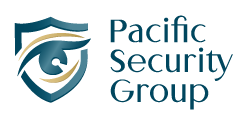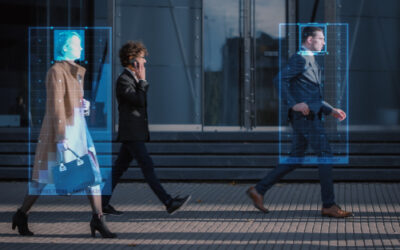The significance of physical security solutions cannot be overstated. As a small business owner, safeguarding your assets, data, and personnel forms the bedrock of maintaining not just the continuity of your operations, but also fostering a secure environment conducive to growth and innovation. The evolving landscape of threats, ranging from burglary and vandalism to more sophisticated risks like espionage, mandates a comprehensive approach to physical security.
Physical security solutions are not just about locking doors or installing cameras; they embody a holistic strategy that intertwines technological advancements with human vigilance. It’s about creating a resilient framework that not only deters potential threats but also minimises the impact should an incident occur. The integration of state-of-the-art surveillance systems, access control mechanisms, and alarm systems, tailored to the unique needs of a small business, forms the cornerstone of this strategy.
Moreover, in an era where a business’s reputation can be its most valuable asset, the role of physical security transcends the mere protection of tangible assets. It’s about instilling confidence among your clients, employees, and stakeholders that your business is a safe haven, thereby enhancing your brand’s integrity and standing in the marketplace.
In essence, the imperative of physical security solutions in today’s business landscape is not just a reactive measure, but a proactive strategy that underpins the very essence of business resilience and sustainability. It’s a testament to a business’s commitment to not just surviving but thriving in the face of adversities.
Core Components of Effective Physical Security Solutions
The cornerstone of any robust physical security strategy lies in its core components, which together form a cohesive shield safeguarding your business. As we delve deeper, it’s crucial to understand how elements such as access control, surveillance, intrusion detection, and the human factor play pivotal roles in fortifying your premises.
Access Control: The First Line of Defence
Access control stands as the vanguard of your physical security apparatus. Technologies like keycards, biometric scanners, and electronic gates do more than just regulate entry; they define the boundaries of your business’s secure zones. The sophistication of these systems can vary, from simple pin code entry pads to advanced biometric identification, ensuring that only authorised personnel gain access. This layer of security is fundamental not only in preventing unauthorised access but also in tracking who is in the premises at any given time, thereby adding a layer of data-driven insight into your security posture.
Vigilant Eyes: The Role of Surveillance and Monitoring
Surveillance systems serve as the omnipresent eyes of your security framework. Security cameras, strategically placed, offer real-time monitoring capabilities that are invaluable in both deterring potential intruders and documenting any untoward incidents. Coupled with sensors and alarms, this surveillance network provides a comprehensive overview of your business environment, ensuring that any aberration from the norm is quickly identified and addressed. The advancement in surveillance technology, including high-definition cameras and motion-sensitive recording, enhances the effectiveness of monitoring, making it a critical component of modern physical security solutions.
Intrusion Detection Systems: Beyond the Front Door
Intrusion detection systems extend the security perimeter beyond the immediate boundaries of your business’s front door. Motion sensors, glass break detectors, and door/window sensors act as an intricate web that senses any unauthorised movement or breach within your premises. These systems are particularly effective after hours, providing an automated layer of security that remains vigilant when human presence is minimal. The integration of these systems into a central security hub ensures that any alerts are promptly addressed, whether by onsite personnel or remote monitoring services.
The Human Element: Security Personnel and Their Impact
While technology plays a crucial role in modern physical security strategies, the human element remains irreplaceable. Security personnel, whether in the form of onsite guards or remote monitoring teams, bring a level of responsiveness and adaptability that machines cannot replicate. Their presence on the ground not only acts as a strong deterrent to potential intruders but also ensures that the execution of security protocols is seamless. In situations where immediate judgement and intervention are required, the value of trained security personnel is immeasurable.
An effective physical security strategy is multi-faceted, incorporating technology, human insight, and procedural rigour. It’s this blend of components, tailored to the specific needs of your business, that ensures a secure and resilient operating environment.
Innovative Approaches to Enhancing Physical Security
When it comes to physical security, innovation is not just about adopting new technologies; it’s about rethinking our approach to safeguarding our businesses. As we explore the frontiers of security measures, it becomes evident that the integration of advanced technologies and strategic planning plays a crucial role in elevating our defence mechanisms.
Leveraging AI Technology:
The advent of artificial intelligence (AI) in the security sector marks a paradigm shift in how we monitor and respond to threats. AI’s ability to sift through vast amounts of data and identify genuine threats is a game-changer, turning reactive security measures into proactive safeguards. This intelligent analysis allows for the efficient allocation of resources, focusing attention where it’s most needed.
Beyond Traditional Measures: Environmental Design and Secure Credentials
Redefining physical security also involves reimagining the spaces in which our businesses operate. Environmental design plays a pivotal role in this, leveraging the layout and architecture of spaces to control traffic flow and reduce vulnerabilities. Strategic placement of barriers, lighting, and landscape elements can naturally deter unauthorised access and enhance surveillance effectiveness. Complementing this, the evolution of secure credential systems, including advanced biometrics and encrypted digital passes, adds a sophisticated layer of security. These systems ensure that access is not only controlled but also monitored and recorded with a high degree of accuracy, adding an additional layer of data for security analysis.
Preparing for the Unexpected: Disaster Recovery Planning
An often overlooked but critical component of physical security is disaster recovery planning. The reality is that no defence is entirely impregnable. Therefore, having a robust plan in place to respond to security breaches or physical threats is paramount. This involves not just a reactionary protocol but a comprehensive strategy encompassing containment, mitigation, and resolution. Effective disaster recovery planning ensures that in the event of a security breach, the impact on your business is minimised, operations can be quickly restored, and lessons are learned to fortify your defences against future incidents.
Innovation in physical security is about harnessing technology, strategic planning, and design to create a security framework that is not only robust but also adaptable and scalable. It’s about anticipating threats, not just responding to them, ensuring that your business remains a safe and secure environment for everyone involved.
Tailoring Physical Security to Small Business Needs
In the intricate dance of safeguarding a small business, recognising, and addressing your unique security requirements is paramount. Tailoring your physical security measures to the specific needs of your business is not a one-size-fits-all approach; it demands a thoughtful analysis of several critical factors.
Assessing Your Unique Security Requirements
The first step in this tailored approach is a comprehensive assessment of your business’s specific security needs. This involves a deep dive into the nature of your operations, the size of your premises, the type of assets you’re protecting, and the level of security required. For a small retail outlet, this might mean focusing on theft prevention and customer safety. In contrast, a small tech firm may prioritise securing its data and intellectual property. Understanding these nuances is crucial in developing a security strategy that offers maximum protection without unnecessary expenditures on redundant measures.
Cost-Effective Security Solutions for Budget-Conscious Businesses
For small businesses, where budget constraints are often a significant consideration, finding cost-effective security solutions is essential. The key is to identify scalable, efficient security measures that offer maximum protection without breaking the bank. This could include investing in multi-functional devices, like cameras that also serve as motion detectors, or opting for a modular security system that allows you to add components as your business grows. Leveraging technology, such as cloud-based surveillance, can also offer significant cost savings, reducing the need for expensive on-site infrastructure.
Scalability and Integration: Future-Proofing Your Security
As your business evolves, so too should your security measures. Scalability and integration become crucial components of a forward-thinking security strategy. Opting for security solutions that can be easily upgraded or integrated with other systems ensures that your security framework can adapt to your business’s changing needs. This might mean choosing an access control system that can be expanded as you hire more staff or integrating your surveillance system with new, more advanced cameras as they become available. The goal is to build a security infrastructure that not only meets your current needs but can also grow with your business, providing long-term value and protection.
Tailoring your physical security to your small business’s unique needs is not just about selecting the right technologies; it’s about adopting a strategic approach that considers your specific requirements, budget constraints, and future growth. By focusing on scalability, integration, and cost-effectiveness, you can ensure that your security measures are not only effective but also sustainable, supporting your business’s success in the long term.
The Human Aspect: Training and Awareness
In the tapestry of physical security, the human element often emerges as the most dynamic and potentially vulnerable component. It’s here, within the realm of training and awareness, that we find a potent opportunity to strengthen our security infrastructure from within. Cultivating a security-conscious workforce is not just an added layer of defence; it’s a fundamental shift towards a more resilient security culture.
Cultivating a Security-Conscious Workforce
The cornerstone of this endeavour lies in comprehensive training programmes designed to elevate employee awareness about the crucial role they play in the overall security posture. This involves more than just the occasional briefing or the passive distribution of security protocols. It’s about engaging employees in regular, interactive training sessions that highlight the importance of security in their daily routines and the potential consequences of complacency.
Training should encompass a broad spectrum of scenarios, from recognising and reporting suspicious activities to understanding the correct procedures for various security incidents. Employees need to be familiar with the access control systems, understand the importance of secure credentials, and be vigilant about maintaining a secure environment. This education fosters a sense of responsibility and empowerment, making every team member an active participant in the security framework.
Moreover, this security-conscious mindset extends beyond the confines of formal training sessions. It’s about creating an environment where security is an ongoing conversation, where suggestions for improvement are encouraged, and where everyone feels invested in the collective safety of the workplace. Regular updates, feedback sessions, and drills can keep the security dialogue vibrant and relevant, adapting to new threats and incorporating fresh insights.
In essence, cultivating a security-conscious workforce is about weaving security into the very fabric of your organisational culture. It transforms employees from potential security liabilities into informed, vigilant guardians of their workspace. In doing so, it not only enhances the efficacy of your physical security measures but also fosters an environment where security is everyone’s business, contributing to a safer, more secure business ecosystem.
Common Threats and How to Counter Them
Navigating the ever-changing threat landscape requires vigilance and adaptability, especially for small businesses that might not have the vast resources of larger corporations. Understanding common threats and crafting strategies to counter them is essential in fortifying your physical security framework.
Addressing the Ever-Changing Threat Landscape
At the forefront of physical security challenges is the issue of unauthorised access. This threat ranges from opportunistic burglaries to more calculated intrusions, with the potential to significantly disrupt business operations and compromise sensitive information. To mitigate this risk, a multi-layered approach to access control is paramount. This could involve a combination of physical barriers, electronic access controls, and stringent identity verification processes, ensuring that only authorised personnel can enter your premises.
Another critical vulnerability lies within your surveillance system itself. As the eyes and ears of your security apparatus, any weakness here can blindside your entire operation. This includes everything from physical tampering with cameras to cyber threats targeting network-connected devices. Ensuring your surveillance system is tamper-proof, regularly maintained, and protected from cyber intrusions is crucial. Employing encrypted communications for surveillance feeds, using secure networks, and regularly updating your software can significantly enhance the resilience of your surveillance infrastructure.
Beyond these specific measures, a holistic approach to security, encompassing regular risk assessments and a culture of security awareness, can help small businesses stay one step ahead. By understanding the nuances of potential threats and continuously evolving your security strategies to counter them, you can create a robust defence mechanism that not only protects your assets but also ensures the continuity and integrity of your business operations.
Key Takeaways
Securing a small business requires more than just a set of locks and alarms; it demands a comprehensive and tailored approach to physical security. Here, we’ve traversed through the multifaceted landscape of safeguarding your enterprise, highlighting key strategies and considerations to fortify your premises against a myriad of threats.
- The Imperative of Physical Security: Ensuring the safety of your assets, data, and personnel is not just a precautionary measure but a cornerstone of business continuity and growth.
- Core Components of a Robust Strategy: An effective physical security framework is built on the pillars of access control, surveillance, intrusion detection, and the invaluable human element, each playing a pivotal role in creating a secure business ecosystem.
- Innovative Approaches: Leveraging advanced technologies like AI and cloud-based solutions, alongside strategic environmental design and disaster recovery planning, can significantly enhance your security posture, making it both resilient and adaptable.
- Tailoring to Small Business Needs: Understanding and addressing the unique security requirements of your business is crucial. Opting for scalable, cost-effective, and integrated security solutions ensures your strategy is both effective and sustainable.
- The Human Aspect: Cultivating a security-conscious workforce through regular training and awareness initiatives transforms your employees into proactive participants in your security strategy, reinforcing the overall defence mechanism.
- Counteracting Common Threats: Staying vigilant against potential threats such as unauthorised access and vulnerabilities in surveillance systems is crucial. Employing a multi-layered approach to access control and ensuring the security of your surveillance infrastructure are key countermeasures.
In conclusion, securing your small business is continuous and ever-evolving. It requires a balanced blend of technology, strategic planning, and human insight. By embracing a comprehensive physical security strategy, tailored to the unique needs and challenges of your business, you not only safeguard your tangible assets but also secure the future and reputation of your enterprise.
FAQs
1. What are physical security solutions for small businesses? Physical security solutions for small businesses involve a comprehensive approach to safeguarding assets, data, and personnel. This includes the use of access control systems, surveillance, intrusion detection, and trained security personnel to create a secure environment.
2. Why are physical security solutions important for small businesses? Physical security solutions are crucial for small businesses as they protect against threats such as burglary, vandalism, and espionage. They help maintain business continuity, instill confidence among clients and employees, and enhance the business’s reputation.
3. What are the core components of an effective physical security strategy? The core components include access control systems (e.g., keycards, biometric scanners), surveillance systems (e.g., security cameras, sensors), intrusion detection systems (e.g., motion sensors, glass break detectors), and the presence of trained security personnel.
4. How does access control contribute to physical security? Access control systems regulate who can enter specific areas within a business, ensuring only authorized personnel have access. This helps prevent unauthorized access and provides data on who is on the premises at any given time.
5. What role do surveillance systems play in physical security? Surveillance systems act as the eyes of a security strategy, offering real-time monitoring and recording of activities. This helps deter potential intruders and provides valuable documentation of incidents for later review.
6. Why are intrusion detection systems important? Intrusion detection systems extend security beyond the immediate premises, detecting unauthorized movement or breaches. They are especially effective after hours, providing automated security when human presence is minimal.
7. How can small businesses ensure cost-effective security solutions? Small businesses can adopt scalable and efficient security measures such as multi-functional devices, modular security systems, and cloud-based surveillance. These solutions provide maximum protection without significant financial strain.
8. What innovative approaches can enhance physical security? Innovative approaches include leveraging artificial intelligence for threat detection, using environmental design to control traffic flow and reduce vulnerabilities, and adopting secure credential systems like advanced biometrics and encrypted passes.
9. Why is disaster recovery planning essential for physical security? Disaster recovery planning prepares businesses to respond effectively to security breaches or physical threats, minimizing impact and ensuring quick recovery. It involves protocols for containment, mitigation, and resolution.
10. How can businesses tailor physical security to their specific needs? Businesses should assess their unique security requirements based on their operations, assets, and premises. Tailoring security measures ensures maximum protection, cost-effectiveness, and scalability to accommodate growth.
11. How can a security-conscious workforce contribute to physical security? A security-conscious workforce, achieved through comprehensive training and regular updates, enhances overall security by making employees vigilant and proactive in maintaining a secure environment.
12. What common threats do small businesses face, and how can they counter them? Common threats include unauthorized access and vulnerabilities in surveillance systems. Businesses can counter these by implementing multi-layered access control, ensuring surveillance system integrity, and maintaining a culture of security awareness.


